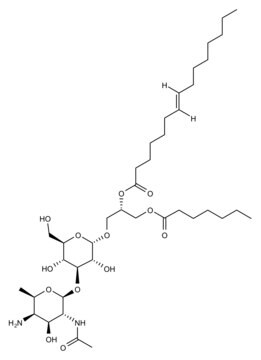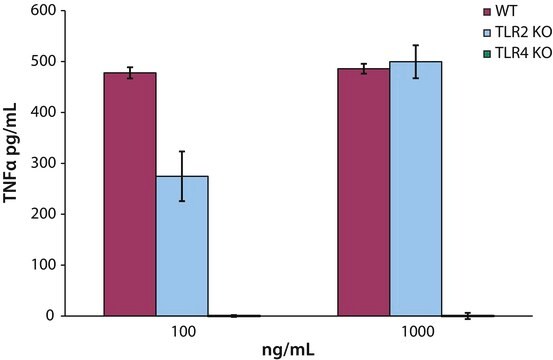L6261
Lipopolysaccharides from Salmonella enterica serotype minnesota
purified by phenol extraction
Sinónimos:
LPS
About This Item
Productos recomendados
biological source
Salmonella enterica (serotype minnesota)
Quality Level
form
lyophilized powder
purified by
phenol extraction
impurities
<3% Protein (Lowry)
solubility
water: soluble
storage temp.
2-8°C
¿Está buscando productos similares? Visita Guía de comparación de productos
General description
Application
- as a toll-like receptors (TLR ) agonist to induce tumor necrosis factor (TNF) α production in cereblon and Rabex-5 deficient mice in vivo,
- to study its effect on prostaglandin-E Synthase (PTGES) protein expression in monocyte-derived macrophages
- as a positive control for the maturation of monocyte-derived dendritic cells (MoDCs) to assess secretion of interleukin-10 and interferon (IFN)-γ
- as a supplement in Roswell park memorial institute (RPMI)media for culturing splenic B cells
- as a toll-like receptor 4 ligand to study its effect on the expression of the proallergic cytokines thymic stromal lymphopoietin (TSLP) and interleukin 33 (IL33) in H292 cells (pulmonary mucoepidermoid carcinoma cells)
Biochem/physiol Actions
Other Notes
Related product
signalword
Danger
hcodes
Hazard Classifications
Acute Tox. 2 Oral
Storage Class
6.1A - Combustible acute toxic Cat. 1 and 2 / very toxic hazardous materials
wgk_germany
WGK 3
flash_point_f
Not applicable
flash_point_c
Not applicable
Certificados de análisis (COA)
Busque Certificados de análisis (COA) introduciendo el número de lote del producto. Los números de lote se encuentran en la etiqueta del producto después de las palabras «Lot» o «Batch»
¿Ya tiene este producto?
Encuentre la documentación para los productos que ha comprado recientemente en la Biblioteca de documentos.
Los clientes también vieron
Nuestro equipo de científicos tiene experiencia en todas las áreas de investigación: Ciencias de la vida, Ciencia de los materiales, Síntesis química, Cromatografía, Analítica y muchas otras.
Póngase en contacto con el Servicio técnico




